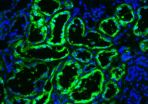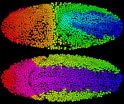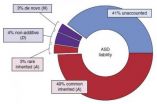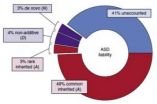(Press-News.org) BOSTON – The most critical barrier for curing HIV-1 infection is the presence of the viral reservoir, the cells in which the HIV virus can lie dormant for many years and avoid elimination by antiretroviral drugs. Very little has been known about when and where the viral reservoir is established during acute HIV-1 infection, or the extent to which it is susceptible to early antiretroviral therapy (ART).
Now a research team led by investigators at Beth Israel Deaconess Medical Center (BIDMC) in collaboration with the U.S. Military HIV Research Program has demonstrated that the viral reservoir is established strikingly early after intrarectal simian immunodeficiency virus (SIV) infection of rhesus monkeys and before detectable viremia.
The findings appear online in the journal Nature.
"Our data show that in this animal model, the viral reservoir was seeded substantially earlier after infection than was previously recognized," explains senior author Dan H. Barouch, MD, PhD, Director of the Center for Virology and Vaccine Research at BIDMC and steering committee member of the Ragon Institute of MGH, MIT and Harvard. "We found that the reservoir was established in tissues during the first few days of infection, before the virus was even detected in the blood."
This discovery coincides with the recently reported news of the HIV resurgence in the "Mississippi baby," who was believed to have been cured by early administration of ART. "The unfortunate news of the virus rebounding in this child further emphasizes the need to understand the early and refractory viral reservoir that is established very quickly following HIV infection in humans," adds Barouch, a Professor of Medicine at Harvard Medical School.
In this new study, the scientific team initiated suppressive ART in groups of monkeys on days 3, 7, 10 and 14 after intrarectal SIV infection. Animals treated on day 3 following infection showed no evidence of virus in the blood and did not generate any SIV-specific immune responses. Nevertheless, after six months of suppressive ART, all of the animals in the study exhibited viral resurgence when treatment was stopped.
While early initiation of ART did result in a delay in the time to viral rebound (the time it takes for virus replication to be observed in the blood following cessation of ART) as compared with later treatment, the inability to eradicate the viral reservoir with very early initiation of ART suggests that additional strategies will be needed to cure HIV infection.
"The strikingly early seeding of the viral reservoir within the first few days of infection is sobering and presents new challenges to HIV-1 eradication efforts," the authors write. "Taken together, our data suggest that extremely early initiation of ART, extended ART duration, and probably additional interventions that activate the viral reservoir will be required for HIV-1 eradication."
INFORMATION:
Study coauthors include first author James Whitney of BIDMC and the Ragon Institute of MGH, MIT and Harvard; BIDMC investigators Srisowmya Sanisetty, Pablo Penaloz-MacMaster, Jinyan Liu, Mayuri Shetty, Lily Parenteau, Crystal Cabral, Jennifers Shields, Stephen Blackmore, Jeffrey Y. Smith, Amanda L. Brinkman, Lauren E. Peter, Sheeba I. Mathew, Kaitlin M. Smith, Erica N. Borducchi; Aliso L. Hill and Daniel I. S. Rosenbloom of Harvard University; Mark G. Lewis of Bioqual, Rockville, MD; Jillian Hattersley, Bei Li, Joseph Hesselgesser, Romas Geleziunas of Gileas Sciences, Foster City, CA; and Merlin L. Robb, Jerome H. Kim and Nelson L. Michael of the Walter Reed Army Institute of Research.
This study was supported, in part, by the US Military Research and Material Command and the US Military HIV Research Program through its cooperative agreement with the Henry M. Jackson Foundation (W81XWH-07-2-0067; W81XWH-11-2-0174); the National Institutes of Health (AI060354; AI078526; AI084794; AI095985; AI096040; AI100645) and the Ragon Institute of MGH, MIT and Harvard.
Beth Israel Deaconess Medical Center is a patient care, teaching and research affiliate of Harvard Medical School, and currently ranks third in National Institutes of Health funding among independent hospitals nationwide.
BIDMC is in the community with Beth Israel Deaconess Hospital-Milton, Beth Israel Deaconess Hospital-Needham, Beth Israel Deaconess Hospital-Plymouth, Anna Jaques Hospital, Cambridge Health Alliance, Lawrence General Hospital, Signature Health Care, Beth Israel Deaconess HealthCare, Community Care Alliance, and Atrius Health. BIDMC is also clinically affiliated with the Joslin Diabetes Center and Hebrew Senior Life and is a research partner of Dana-Farber/Harvard Cancer Center. BIDMC is the official hospital of the Boston Red Sox. For more information, visit http://www.bidmc.org.
New findings show strikingly early seeding of HIV viral reservoir
Discovery presents new challenges for HIV eradication efforts
2014-07-20
ELSE PRESS RELEASES FROM THIS DATE:
Metabolic enzyme stops progression of most common type of kidney cancer
2014-07-20
PHILADELPHIA -- In an analysis of small molecules called metabolites used by the body to make fuel in normal and cancerous cells in human kidney tissue, a research team from the Perelman School of Medicine at the University of Pennsylvania identified an enzyme key to applying the brakes on tumor growth. The team found that an enzyme called FBP1 – essential for regulating metabolism – binds to a transcription factor in the nucleus of certain kidney cells and restrains energy production in the cell body. What's more, they determined that this enzyme is missing from all kidney ...
Scientists map one of most important proteins in life -- and cancer
2014-07-20
Scientists reveal the structure of one of the most important and complicated proteins in cell division – a fundamental process in life and the development of cancer – in research published in Nature today (Sunday).
Images of the gigantic protein in unprecedented detail will transform scientists' understanding of exactly how cells copy their chromosomes and divide, and could reveal binding sites for future cancer drugs.
A team from The Institute of Cancer Research, London, and the Medical Research Council Laboratory of Molecular Biology in Cambridge produced the first ...
Marmoset sequence sheds new light on primate biology and evolution
2014-07-20
HOUSTON – (July 20, 2014) – A team of scientists from around the world led by Baylor College of Medicine and Washington University in St. Louis has completed the genome sequence of the common marmoset – the first sequence of a New World Monkey – providing new information about the marmoset's unique rapid reproductive system, physiology and growth, shedding new light on primate biology and evolution.
The team published the work today in the journal Nature Genetics.
"We study primate genomes to get a better understanding of the biology of the species that are most closely ...
Speedy computation enables scientists to reconstruct an animal's development cell by cell
2014-07-20
Recent advances in imaging technology are transforming how scientists see the cellular universe, showing the form and movement of once grainy and blurred structures in stunning detail. But extracting the torrent of information contained in those images often surpasses the limits of existing computational and data analysis techniques, leaving scientists less than satisfied.
Now, researchers at the Howard Hughes Medical Institute's Janelia Research Campus have developed a way around that problem. They have created a new computational method to rapidly track the three-dimensional ...
Common gene variants account for most genetic risk for autism
2014-07-20
Most of the genetic risk for autism comes from versions of genes that are common in the population rather than from rare variants or spontaneous glitches, researchers funded by the National Institutes of Health have found. Heritability also outweighed other risk factors in this largest study of its kind to date.
About 52 percent of the risk for autism was traced to common and rare inherited variation, with spontaneous mutations contributing a modest 2.6 percent of the total risk.
"Genetic variation likely accounts for roughly 60 percent of the liability for autism, ...
Genetic risk for autism stems mostly from common genes
2014-07-20
PITTSBURGH—Using new statistical tools, Carnegie Mellon University's Kathryn Roeder has led an international team of researchers to discover that most of the genetic risk for autism comes from versions of genes that are common in the population rather than from rare variants or spontaneous glitches.
Published in the July 20 issue of the journal "Nature Genetics," the study found that about 52 percent of autism was traced to common genes and rarely inherited variations, with spontaneous mutations contributing a modest 2.6 percent of the total risk. The research team — ...
A noble gas cage
2014-07-20
Richland, Wash. -- When nuclear fuel gets recycled, the process releases radioactive krypton and xenon gases. Naturally occurring uranium in rock contaminates basements with the related gas radon. A new porous material called CC3 effectively traps these gases, and research appearing July 20 in Nature Materials shows how: by breathing enough to let the gases in but not out.
The CC3 material could be helpful in removing unwanted or hazardous radioactive elements from nuclear fuel or air in buildings and also in recycling useful elements from the nuclear fuel cycle. CC3 ...
New method for extracting radioactive elements from air and water
2014-07-20
LIVERPOOL, UK – 20 July 2014: Scientists at the University of Liverpool have successfully tested a material that can extract atoms of rare or dangerous elements such as radon from the air.
Gases such as radon, xenon and krypton all occur naturally in the air but in minute quantities – typically less than one part per million. As a result they are expensive to extract for use in industries such as lighting or medicine and, in the case of radon, the gas can accumulate in buildings. In the US alone, radon accounts for around 21,000 lung cancer deaths a year.
Previous ...
Singapore scientists discover genetic cause of common breast tumours in women
2014-07-20
Singapore, 21 July 2014 – A multi-disciplinary team of scientists from the National Cancer Centre Singapore, Duke-NUS Graduate Medical School Singapore, and Singapore General Hospital have made a seminal breakthrough in understanding the molecular basis of fibroadenoma, one of the most common breast tumours diagnosed in women. The team, led by Professors Teh Bin Tean, Patrick Tan, Tan Puay Hoon and Steve Rozen, used advanced DNA sequencing technologies to identify a critical gene called MED12 that was repeatedly disrupted in nearly 60% of fibroadenoma cases. Their findings ...
New technique maps life's effects on our DNA
2014-07-20
Researchers at the BBSRC-funded Babraham Institute, in collaboration with the Wellcome Trust Sanger Institute Single Cell Genomics Centre, have developed a powerful new single-cell technique to help investigate how the environment affects our development and the traits we inherit from our parents. The technique can be used to map all of the 'epigenetic marks' on the DNA within a single cell. This single-cell approach will boost understanding of embryonic development, could enhance clinical applications like cancer therapy and fertility treatments, and has the potential ...
LAST 30 PRESS RELEASES:
Numbers in our sights affect how we perceive space
SIMJ announces global collaborative book project in commemoration of its 75th anniversary
Air pollution exposure and birth weight
Obstructive sleep apnea risk and mental health conditions among older adults
How talking slows eye movements behind the wheel
The Ceramic Society of Japan’s Oxoate Ceramics Research Association launches new international book project
Heart-brain connection: international study reveals the role of the vagus nerve in keeping the heart young
Researchers identify Rb1 as a predictive biomarker for a new therapeutic strategy in some breast cancers
Survey reveals ethical gaps slowing AI adoption in pediatric surgery
Stimulant ADHD medications work differently than thought
AI overestimates how smart people are, according to HSE economists
HSE researchers create genome-wide map of quadruplexes
Scientists boost cell "powerhouses" to burn more calories
Automatic label checking: The missing step in making reliable medical AI
Low daily alcohol intake linked to 50% heightened mouth cancer risk in India
American Meteorological Society announces Rick Spinrad as 2026 President-Elect
Biomass-based carbon capture spotlighted in newly released global climate webinar recording
Illuminating invisible nano pollutants: advanced bioimaging tracks the full journey of emerging nanoscale contaminants in living systems
How does age affect recovery from spinal cord injury?
Novel AI tool offers prognosis for patients with head and neck cancer
Fathers’ microplastic exposure tied to their children’s metabolic problems
Research validates laboratory model for studying high-grade serous ovarian cancer
SIR 2026 delivers transformative breakthroughs in minimally invasive medicine to improve patient care
Stem Cell Reports most downloaded papers of 2025 highlight the breadth and impact of stem cell research
Oxford-led study estimates NHS spends around 3% of its primary and secondary care budget on the health impacts of heat and cold in England
A researcher’s long quest leads to a smart composite breakthrough
Urban wild bees act as “microbial sensors” of city health.
New study finds where you live affects recovery after a hip fracture
Forecasting the impact of fully automated vehicle adoption on US road traffic injuries
Alcohol-related hospitalizations from 2016 to 2022
[Press-News.org] New findings show strikingly early seeding of HIV viral reservoirDiscovery presents new challenges for HIV eradication efforts





